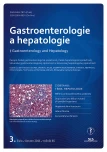-
Medical journals
- Career
Hepatocellular carcinoma – diagnosis and treatment from the medical oncology perspective
Authors: J. Tomášek 1; Š. Tuček 1; T. Andrašina 2
Authors‘ workplace: Klinika komplexní onkologické péče, MOU a LF MU, Brno2Radiologická klinika, LF MU a FN Brno 1
Published in: Gastroent Hepatol 2011; 65(3): 149-153
Category: Hepatology: Rewiev Article
Overview
Hepatocellular carcinoma (HCC) in the Czech Republic represents a small group of tumours. Unlike other countries, in the Czech Republic screening is of limited value. However, it has been recommended by the expert panel for groups at major risk – patients with hepatic cirrhosis and patients with hepatitis B and C. The choice of a method of treatment and its success depend on the extent of the malignant disease and the functional impairment of remaining liver parenchyma. The curative treatment includes surgical resection or radiofrequency ablation, and liver transplantation. The palliative methods proven as effective include trans-arterial chemoembolization (TACE), percutaneous ethanol injection (PEI), and the only systemic treatment, with sorafenib. The diagnostic and therapeutic workup uses a multidisciplinary approach and belongs to specialized centres. Thank to the multidisciplinary approach and the improvement in communication between various institutions, the optimal procedure has become achievable for more patients.
Key words:
liver cirrhosis – hepatocellular carcinoma – sorafenib – liver transplantation – transarterial chemo-embolisation
Sources
1. Národní onkologický registr (NOR), www.svod.cz (duben 2011).
2. Jelic S, Sotiropoulos GC. Hepatocellular carcinoma: ESMO Clinical Practice Guidelines for diagnosis, treatment and follow-up. Annals of Oncology 2010; 21 (Suppl 5): v59–v64.
3. Zang BH, Yang BH, Tang ZY. Randomized controlled trial of screening for hepatocellular carcinoma. J Cancer Rec Clin Oncol 2004; 130 : 417–422.
4. Forner A, Reig ME, de Lope CR et al. Current strategy for staging and treatment: the BCLC update and future prospects. Semin Liver Dis 2010; 30(1): 61–74.
5. Novotný J. Klinický registr pro hepatocelulární karcinom. Klin Onkol 2010; 23(3): 185–186.
6. Ioannou GN, Perkins JD, Carithers RL Jr. Liver transplantation for hepatocellular carcinoma: impact of the MELD allocation system and predictors of survival. Gastroenterology 2008; 134(5): 1342–1351.
7. Hemming AW, Cattral MS, Reed AI et al. Liver transplantation for hepatocellular carcinoma. Ann Surg 2001; 233(5): 652–659.
8. Yao FY, Ferrell L, Bass NM et al. Liver transplantation for hepatocellular carcinoma: comparison of the proposed UCSF criteria with the Milan criteria and the Pittsburgh modified TNM criteria. Liver Transpl 2002; 8(9): 765–774.
9. Sotiropoulos GC, Molmenti EP, Lang H. Milan criteria, up-to-seven criteria, and the illusion of a rescue package for patients with liver cancer. Lancet Oncol 2009; 10(3): 207–208.
10. Mazzaferro V, Battiston C, Perrone S et al. Radiofrequency ablation of small hepatocellular carcinoma in cirrhotic patients awaiting liver transplantation: a prospective study. Ann Surg 2004; 240(5): 900–909.
11. Lo CM, Ngan H, Tso WK et al. Randomized controlled trial of transarterial lipiodol chemoembolization for unresectable hepatocellular carcinoma. Hepatology 2002; 35(5): 1164–1171.
12. Boudný J, Válek V, Műller H et al. Perkutánní léčba a regionální aplikační techniky u nemocných s maligními ložiskovými procesy v játrech. In: Maligní ložiskové procesy jater, diagnostika a léčba včetně minimálně invazivních metod. Praha: Grada 2008 : 345–397.
13. Kiss I, Tomášek J, Vyzula R et al. Chemoterapie a konzervativní terapie nemocných s maligními ložiskovými procesy jater. In: Válek V, Kala Z, Kiss I et al. Maligní ložiskové procesy jater, diagnostika a léčba včetně minimálně invazivních metod. Praha: Grada 2008. 321–344.
14. Yeo W, Mok TS, Zee B et al. A randomized phase III study of docorubicin vs cisplatin/interferon alpha-2b/doxorubicin/fluorouracil (PIAF) combination chemotherapy for unresectable hepatocellular carcinoma. J Natl Cancer Inst 2005; 97(20): 1532–1538.
15. Tesařová P. Místo sorafenibu v léčbě hepatocelulárního karcinomu. Čes a Slov Gastroent a Hepatol 2010; 64(5): 15–21.
16. Llovet JM, Ricci S, Mazzaferro V et al. For the SHARP Investigators Study Group: Sorafenib in advanced hepatocellular carcinoma. N EnglJ Med 2008; 359(4): 378–390.
17. Cheng AL, Kang YK, Chen Z et al. Efficacy and safety of sorafenib in patients in the Asia-Pacific region with advanced hepatocellular carcinoma: a phase III randomised, double-blind, placebo-controlled trial. Lancet Oncol 2009; 10(1): 25–34.
18. Bruix J, Sherman M. AASLD PRACTICE GUIDELINE Management of Hepatocellular Carcinoma: An Update. Hepatology 2011; 53(3): 1020–1022.
Labels
Paediatric gastroenterology Gastroenterology and hepatology Surgery
Article was published inGastroenterology and Hepatology

2011 Issue 3-
All articles in this issue
- Welcome on board!
- Importance of the United European Gastroenterology Federation increases and may set an example for political structures
- Hepatology in the third millennium
- Biochemical evaluation of the effect of silymarin and praziquantel on hepatic fibrogenesis during experimental larval infection of the parasitic helminth Mesocestoides vogae (Cestoda)
- Serum concentration of hyaluronic acid correlates with the degree of fibrosis and portal hypertension
- Radial endosonography vs. oesophagogastroduodenoscopy in detecting oesophageal and gastric varices
- Importance of portosystemic pressure gradient measurement (HVPG) in patients with liver cirrhosis
- Hepatocellular carcinoma – diagnosis and treatment from the medical oncology perspective
- Unusual complication of chronic pancreatitis
- Quantitative immunochemical fecal occult blood test in population screening of colorectal cancer
-
Which non-steroidal anti-inflammatory drug should be used in patients with increased risk of gastrointestinal toxicity?
Commentary on CONDOR study - Opinions on (intervention) treatment of acute pancreatitis are changing
- OTSC system training on porcine models
- American gastroenterology – is the situation worsening?
- Guidelines on the diagnosis and treatment of bleeding into the digestive tract caused by portal hypertension
- Gastroenterology and Hepatology
- Journal archive
- Current issue
- Online only
- About the journal
Most read in this issue- Importance of portosystemic pressure gradient measurement (HVPG) in patients with liver cirrhosis
- Hepatocellular carcinoma – diagnosis and treatment from the medical oncology perspective
- Unusual complication of chronic pancreatitis
- Serum concentration of hyaluronic acid correlates with the degree of fibrosis and portal hypertension
Login#ADS_BOTTOM_SCRIPTS#Forgotten passwordEnter the email address that you registered with. We will send you instructions on how to set a new password.
- Career

